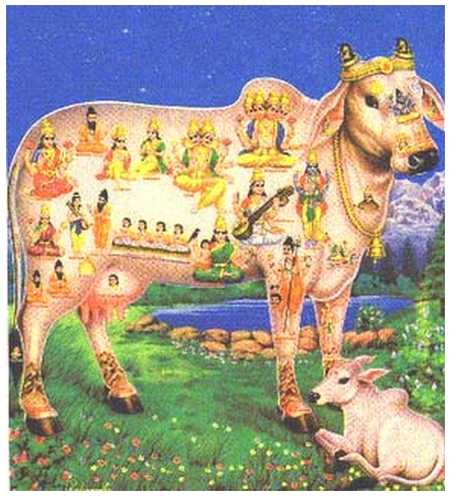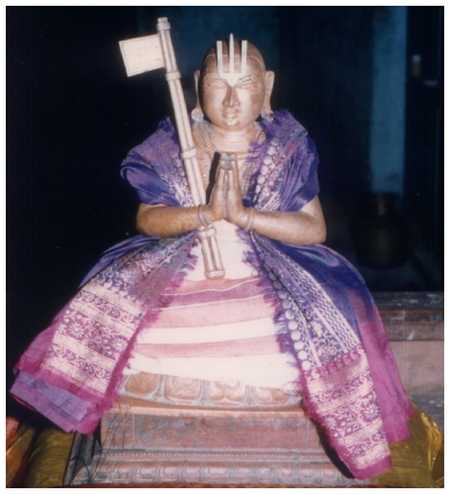Article by : Sadagopan Iyengar Swami, Coimbatore
When I started writing on this subject, I thought I would be able to conclude it in about 4 or 5 pages, as usual. However, the wealth of information available and the reluctance to leave out even not- so- significant matters, resulted in its running on to 22 pages. And when I decided to split it up for readers’ convenience, it naturally ended up in four parts!

Well, we had ended the previous part with the four methods of accomplishing things.
The Four Directions
My son reminds me that the directions too are four in number’North, South, East and West. Here are some interesting tidbits about directions. The Kaataka Prasnam tells us that Agni the Fire God is the deity of East, Indra of South, Soma of West and Mitraavaruna, of North. However, the overall Lord and Master of all directions is Vishnu”Vishnavaasaanaam pate!’ It is the same Kaatakam which points out the association of directions with Vedas’East with Rg Veda, South with Yajur Veda, West with Atharva Veda and North with Saama Veda. At the time of Creation, all these four directions came out of the Paramaatma’s ears, says the Purusha Suktam”Padbhyaam bhoomi: disa: shrotraat’.
Four Types of Saranaagati
Prapatti or Saranaagati too is said to be of four types. According to the Saranaagati Deepika of Swami Desikan, those who surrender to the Lord adopt one of the following paths-
1. ‘Svanishtta’ People with exceptional clarity about the nature of themselves, the Lord, the way to reach Him, etc., can perform Prapatti on their own. Sri Ramanuja’s Prapatti at the lotus feet of the Divya Dampatis at Srirangam on Panguni Uttaram is an outstanding example of Svanishtta.
2. ‘Ukti Nishtta’Performance of Prapatti with the guidance of the Acharya, repeating the Saranaagati Mantra after him, is known as Ukti Nishtta.
3. ‘Acharya Nishtta’ Here, the Acharya himself performs Prapatti on our behalf.
4. ‘Bhaagavata Nishtta’ A Bhaagavata of good standing, other than the Acharya, with exceptional devotion, performs Prapatti on our behalf.
However, whichever be the type of Prapatti, it is the Lord who makes us perform the same, out of His infinite mercy for our eternal wellbeing, ridding us of the twin shackles of sin and merit and making us eligible for boundless bliss.
Here is the beautiful slokam from Saranaagati Deepika’
‘Bhakti: Prapatti: athavaa Bhagavan! Tat ukti:
Tannishtta samshraya iteeva vikalpyamaanam
Yam kanchit ekam upapaadayataa tvayaiva
Traataa: taranti avasare bhavino bhavaabdhim’
Four Yogaasanaas:
Here are some miscellaneous quartets. Those conversant with Yogaasanaas would know that the principal Asaanas are four in number:
1. Bhadram
2. Siddham
3. Simham
4. Padmam
Of these, Siddhaasana is supposed to be the best according to the Hata Yoga Pradeepika
‘Siddham Padmam tathaa Bhadram veti chatushtayam
shreshttam tatraapi cha sukhe tishttet Siddhaasane sadaa’
Rama and Number Four:
We have seen how Sri Rama had four great teeth”Chatur Damshtra:’. We are told by Valmiki that Sri Rama had four lines on His broad and beautiful forehead, four lines at the bottom of His thumb signifying four Vedas and that His height was equal to four arm-lengths. Four pairs of His body parts were absolutely equal to each other’His arms, knees, thighs and cheeks. All the aforesaid characteristics signify a great man”Uttama Purusha’ and are in conformity with Saamudrika Lakshanam. Sri Hanuman delights in describing these aspects of Sri Raghava’s physical features to Sri Mythily’
‘Chatushkala: chatur lekha: chatushkishku: chatu: sama:
Chaturdasa sama dvandva: chatur damshtra: chatur gati’
When it is time for Sri Rama’s coronation, holy water is brought by four Vaanara veeras in four golden pots, from the four oceans of the world.
The Four Ramas: We have heard of three Ramas ‘Parasurama, Dasaratha Rama and Balarama. Swami Desikan speaks of a fourth Rama, who has all the auspicious aspect of the other three Ramas combined, without any of their apparent shortcomings “Raamam turyam upaasmahe’. And who is this mysterious fourth Rama? It is none other than Sri Mankkaal Nambi, (also known as Sri Rama Misra) the Acharya of Sri Alavandaar. But for his diverting Sri Alavandar from mundane pursuits and exposing him to Bhagavat anubhavam, our Sampradaya would have been much poorer. The immense contribution of Sri Alavandar would have been totally unavailable to us, but for the stellar role played by Sri Rama Misra and this is the reason for Swami Desikan’s glowing tribute to the Acharya, putting him on a pedestal higher than that occupied by even the Lord.

Says Swami Desikan in Sri YatirAja Saptati
‘I pay obeisance to Rama the Fourth, who is much greater than the three earlier and divine Ramas put together. Sri Parasurama lacked tolerance and mercilessly eliminated the ruling class for twenty-one generations. Our fourth Rama, however, is patience and tolerance personified. Sri Dasaratha Rama vowed to rid the world of bestial rAkshasAs and carried out His vow effectively, resulting in a massacre of the race. The Fourth Rama, however, would not harm even an ant, leave alone cause distress to people, good or bad. Sri Balarama was known for His partiality to ‘madhu’, with eyes reddish and demeanour affected by imbibing such beverages. Rama the Fourth, however, is purity personified, unaffected by baser instincts’.
Miscellaneous Items
Four-legged Creatures: Some may be under the mistaken impression that the Vedas are meant solely for human welfare. Not so– Veda mantras invariably include four-legged creatures while praying for universal welfare .
Speaking of the four-legged, which would you consider to be the greatest of animals? The Mahabharata tells us that it is the Cow.
‘Braahmano dvipadaam shreshtta: Gou: varishttaa chatushpadaam
Guru: gareeyasaam shreshtta: Putra: sparsavataam vara:’
Sri Ramanuja’s Sri Bhaashyam, his lucid commentary on the Brahma Sootraas, has four chapters and eawch of the chapters consists of four parts or Paadaas. The first chapter shows up the Brahmam as the sole cause of creation, sustenance and destruction of the world. The second chapter establishes Brahmam as the material and instrumental cause of this world. While the third chapter describes the means of attaining the Lord, the fourth defines and details the concept of salvation.
Four Letters: All of us know how potent the eight-lettered Mantra, the Ashtaaksharam is and the glory of its purport. However, not all the eight letters are required to rid us of our sin and to enable our ascent to exalted worlds. Utterance of just four of these letters, viz., ‘Narayana’ would do the trick, avers the Bhaagavata Puraanam, recounting the story of Ajaamila. Though guilty of the vilest of sins, Ajaamila could ascend to the worlds above through the mere utterance of the name Narayana, not even addressed to the Lord, but merely to his son. Ajaamila was merely calling his son Narayana while drawing his last breath and this act was enough for him to be cured of all his sins and to be taken to Vishnulokam. Tongues which do not utter these four letters are not tongues at all, but mere worthless flesh, says the Silappadhikaaram’Narayana ennaa naa ennna naave’.
The Four Sacred Books: Every Sri Vaishnava is expected to learn the contents of four sacred books, from an Acharya. These are Sri Ramanuja’s commentaries on the Brahma Sutras (Sri Bhaashyam) and the Bhagavat Gita (Gita Bhaashyam, with Swami Desikan’s gloss Taatparya Chandrika), commentaries on Sri Nammazhwar’s glorious verses of Tiruvaaimozhi and Swami Desikan’s magnum opus Srimad Rahasya Traya Saaram.
Secular Significance of Four
To conclude this piece (at last) and before you conclude that the importance of Number 4 is only spiritual, let me point out its secular significance. According to Mathematicians, Four is the smallest complex number. Four is the smallest composite number that is equal to the sum of its prime factors. A circle divided by 4 makes right angles. Because of it, 4 is the base number of Plane Mathematics. Four is the only number in the English language, for which the number of letters in its name is equal to the number itself. This is also true in several other languages. Four is the sacred number of the Zia, an indigenous tribe located in the US State of New Mexico. The mammalian heart consists of four chambers. Most vehicles have four wheels. Most furniture has four legs – tables, chairs, etc. Four is considered an unlucky number in Chinese, Korean and Japanese cultures because it sounds like the word “death” in the local language. Due to that, many numbered product lines skip the “four”: e.g. Nokia Cell Phones (there is no series beginning with a 4). The armed forces, in olden days, used to consist of four divisions ‘Ratha, Gaja, Turaga and Padaadi’ The Chariot-borne forces, Elephant-borne fighters, the Cavalry and the Infantry, collectively known as the Chaturanga Sena.
Writers would agree that writing is not difficult per se–it is only the problems of choosing an appropriate beginning and a suitable ending, that pose difficulty. Just as I was wondering how to wind up this article, there was a huge roar from my neighbour’s TV, signifying the crowd’s rapture over another World Cup boundary – four runs. As this appears to be a good exit point, let me stop here, though I have by no means exhausted the possibilities of Number Four.
Srimate Sri LakshmiNrisimha divya paduka sevaka SrivanSatakopa Sri Narayana Yatindra Mahadesikaya nama:
dasan, sadagopan
Article by : Sadagopan Iyengar Swami, Coimbatore









thanks you sir. just ready all your ‘four’ articles on the Fabulous Four topic.
very well written sir. plz accept
regards
Jai Sriman Narayanaya.
very informative and enlightening article.